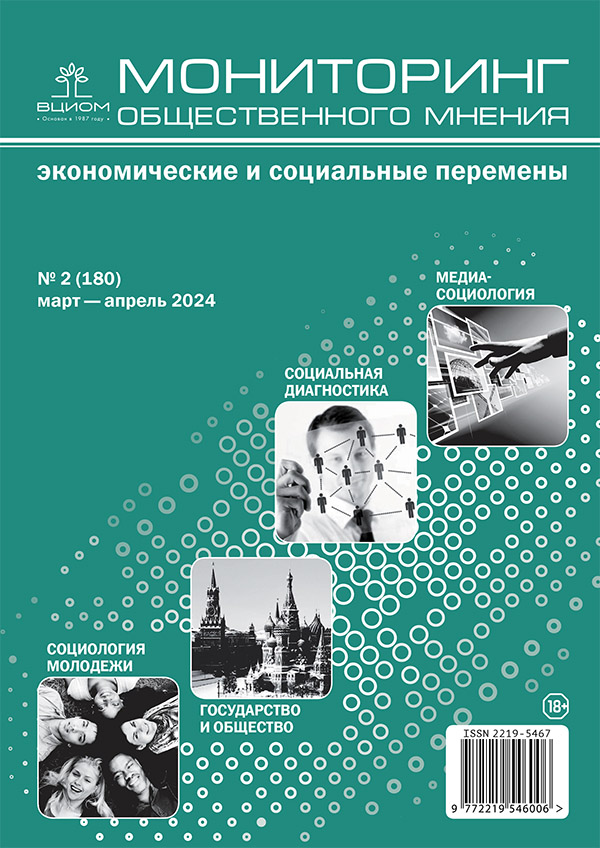Racial Profiling of Roma: Operation «Tabor» as an Unintended Result of the Politicization of Child Neglect and Securitizing Practice
DOI:
https://doi.org/10.14515/monitoring.2024.2.2477Keywords:
racial profiling, securitization, symbolic power, discourses, practices, operation «Tabor»Abstract
This article attempts to move beyond traditional approaches to the study of racial profiling by placing it in the context of securitization studies. To overcome the contradictions existing within this scientific direction, the author uses approach proposed by Pierre Bourdieu, according to which the performative (a key concept in the theory of securitization) is considered as a manifestation of symbolic power.
The empirical basis of the study was more than 3,000 documents containing official orders and reports on anti-Roma raids, as well as calls to the population to be vigilant against Roma. The author shows that ethnically selective policing can be analyzed as a complex of securitizing practices that generate derivative securitizing discourses. To confirm this, the author conducts a case study of racial profiling of Roma. The analysis made it possible to establish that all-Russian anti-Gypsy raids were an unintended consequence of steps to securitize child homelessness and neglect taken by major political players at the turn of 2001/2002.
The proliferation and institutionalization of anti-Roma activities were possible due to the favorable or neutral reaction of most audiences observing the unfolding securitizing practices.
The routinization of anti-Roma raids has led to the fact that they are now perceived as something common and unproblematized, although this practice is clearly a type of ethnic discrimination and goes beyond the scope of «normal politics».
At the same time, participants in anti-Roma events, having internalized the perception of Roma as a source of threat and legitimate suspicion, unreflectively replicate securitizing discourses that mark the Roma population as a dangerous and unreliable group, upon meeting which citizens of a different ethnicity should take precautions or contact the police.
References
Григорьева К. С. Расовое профилирование. История и современное состояние исследований // Демографическое обозрение. 2019. Т. 6. No 4. С. 104—127. https://doi.org/10.17323/demreview.v6i4.10429.
Grigoryeva K. S. (2019) Racial Profiling: The History and Current State of Research. Demographic Review. Vol. 6. No. 4. P. 104—127. https://doi.org/10.17323/demreview.v6i4.10429.
Гудков Л.* Негативная идентичность. Статьи 1997–2002 годов. М.: Новое литературное обозрение, ВЦИОМ-А, 2004.
Gudkov L.* (2004) Negative identity. Research papers 1997–2002. Moscow: New Literary Observer, VTSIOM-A.
Нам И. В. Цыганский вопрос // Бюллетень Сети этнологического мониторинга и раннего предупреждения конфликтов. 2003. № 47. Янв.–февр. С. 60–62.
Nam I. V. (2003) The Roma Question. Bulletin of the Ethnological Monitoring and Early Conflict Prevention Network. No. 47. Jan. — Feb. P. 60-62.
Европейская комиссия по борьбе с расизмом и нетерпимостью. Общеполитическая рекомендация Европейской комиссии по борьбе с расизмом и нетерпимостью № 11: «О борьбе с расизмом и расовой дискриминацией в работе правоохранительных органов». 2007. URL: https://rm.coe.int/compilation-of-ecri-sgeneral-policy-recommendations-march-2018-russia/1680923e0a (дата обращения: 10.03.2024).
The European Commission against Racism and Intolerance (2007) ECRI General Policy Recommendation No. 11 on Combating Racism and Racial Discrimination in Policing. URL: https://rm.coe.int/ecri-general-policy-recommendation-no-11-on-combating-racism-and-racia/16808b5adf (accessed: 10.03.2024).
Balzacq T., Başaran T., Bigo D., Guittet E.-P., Olsson C. (2010) Security Practices. In Denemark R. A. (ed.) The International Studies Encyclopedia Online. URL: https://is.muni.cz/el/fss/podzim2015/ESS419/um/Balzaq_et_al_2010.pdf (accessed: 10.03.2024).
Bigo D. (2002) Security and Immigration: Toward a Critique of the Governmentality of Unease. Alternatives. Vol. 27. P. 63-92. URL: https://migrantsproject.eu/wp-content/uploads/2020/08/Bigo_Security-and-Immigration.pdf (accessed: 10.03.2024).
Bourbeau Ph. (2014). Moving Forward Together: Logics of the Securitisation Process. Millennium: Journal of International Studies. Vol. 43. No. 1. P. 187–206. https://doi.org/10.1177/0305829814541504.
Bourdieu P. (1991) Language and Symbolic Power. London: Polity Press.
Butler J. (1997) Excitable Speech A Politics of the Performative. New York, NJ; London: Routledge.
Buzan B., Wæver O., De Wilde J. (1998) Security: A New Framework for Analysis. Boulder, CO: Lynne Reiner.
Côté A. (2016) Agents without Agency: Assessing the Role of the Audience in Securitization Theory. Security Dialogue. Vol. 47. No. 6. P. 1-18.
Derrida J. (1988) Signature. Event. Context. In: Derrida J. Limited Inc. Evanston: Northwestern University Press. P. 1–25.
Engel R.S., Calnon J.M., Bernard T.J. (2004) Theory and Racial Profiling: Shortcomings and Future Directions in Research. Justice Quarterly. Vol. 19. No. 2. P. 249-273. https://doi.org/10.1080/07418820200095231.
Goris I., Jobard F., Lévy R. (2009) Police et minorités visibles: les contrôles d’identité à Paris. New York, NY: Open Society Institute.
Lamberth J. (1996) A Report to the ACLU. New York, NY: America Civil Liberties Union.
McDonald M. (2008) Securitization and the Construction of Security. European Journal of International Relations. Vol. 14. No. 4. P. 563-587. https://doi.org/10.1177/1354066108097553.
Miller J., Gounev Ph., Pap A.L., Wagman D., Balogi A., Bezlov T., Simonovits B., Vargha L. (2008) Racism and Police Stops: Adapting US and British Debates to Continental Europe. European Journal of Criminology. Vol. 5. No. 2. P. 161–189. https://doi.org/10.1177/1477370807087641.
Pap A. L. (2011) Ethnic Profiling and Discrimination: The International Context and Hungarian Empirical Research Findings. Acta Juridica Hungarica. Vol. 52. No. 4. P. 273–295. https://doi.org/10.1556/AJur.52.2011.4.1.
Spitzer E. (1999) The New York City Police Department’s 'Stop and Frisk' Practices: A Report to the People of the State of New York from the Office of the Attorney General. Albany, NY: New York Attorney General’s Office.
Salter M. B. (2008) Securitization and Desecuritization: A Dramaturgical Analysis of the Canadian Air Transport Security Authority. Journal of International Relations and Development. Vol. 11. No. 4. P. 321-349.
Stritzel H. (2007) Towards a Theory of Securitization: Copenhagen and Beyond. European Journal of International Relations. Vol. 13. No. 3. P. 357-383. https://doi.org/10.1177/1354066107080128.
Trombetta M. J. (2014) Linking Climate-Induced Migration and Security within the EU: Insights from the Securitization Debate. Critical Studies on Security. Vol. 2. No. 2. P. 131-147. https://doi.org/10.1080/21624887.2014.923699.
* 14.02.2025 внесен в реестр иностранных агентов.
Downloads
Published
How to Cite
Issue
Section
License
Copyright (c) 2024 Monitoring of Public Opinion: Economic and Social Changes (ISSN 2219-5467)

This work is licensed under a Creative Commons Attribution-NonCommercial-ShareAlike 4.0 International License.






